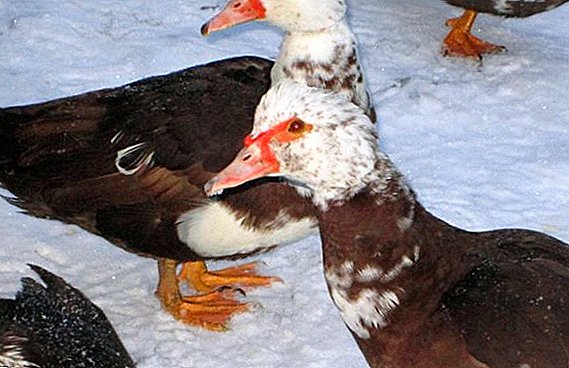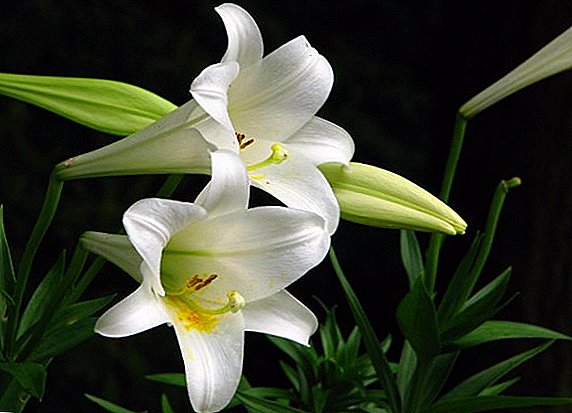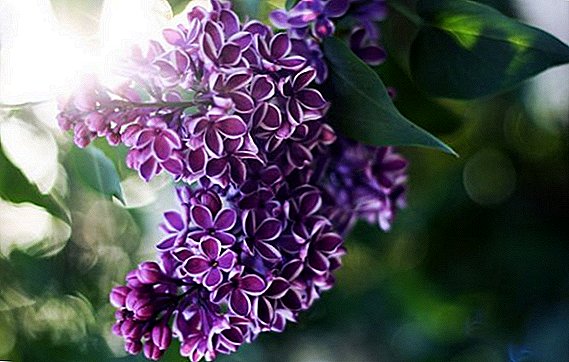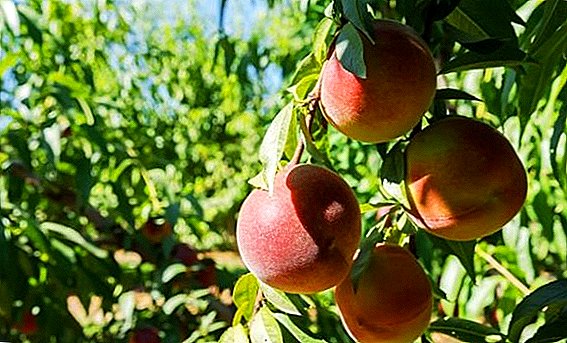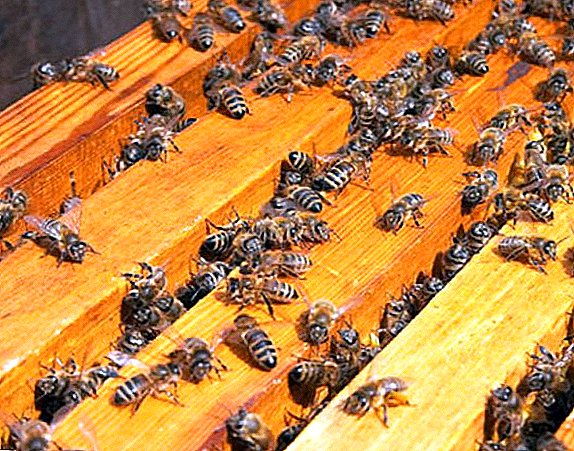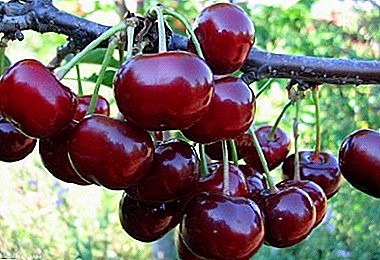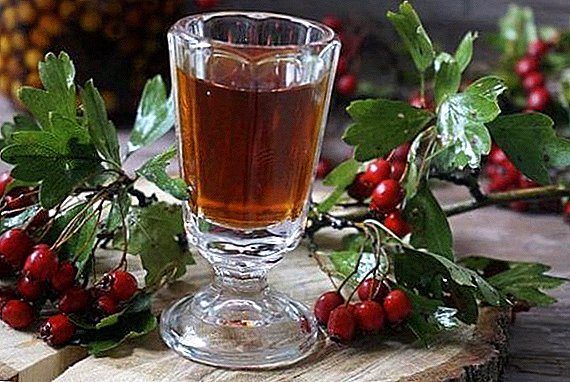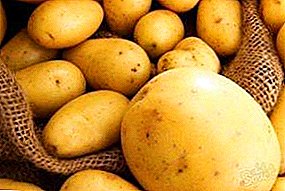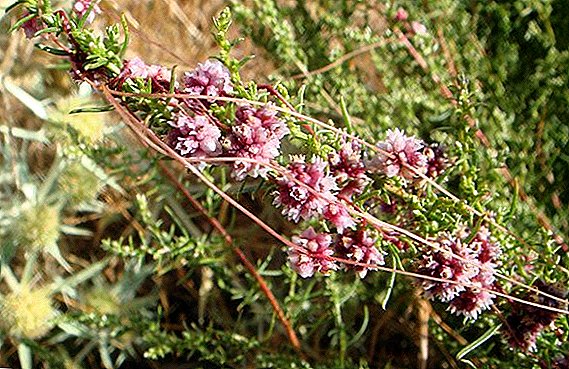
Dodder European is known to many gardeners as a parasitic plant. This plant is a quarantine weed and can damage many agricultural crops (melons, fodder, vegetable and even fruit trees). The European weed subspecies is a representative of the genus Dodder. This genus includes more than 200 species of parasitic plants. In this article we will talk about the biological description of the weed, its chemical composition, beneficial properties and contraindications, as well as how to deal with European dodder in the garden and in the garden.
Description and photo
Dodder European or kuskut is a herbaceous plant, a parasite liana. Kuskut is completely devoid of chlorophyll and roots, its leaves are very small, resembling scales. Because of this structure, the plant can not independently obtain all the important trace elements from the soil and from the sun, so he has to find a host plant. Attached to the dodder host with special suction cups. Stems kuskuty reach a length of 1 m, with a diameter of 2.5 mm.
Weeds can bring not only harm, but also benefit. Learn about the beneficial properties of milkweed, dodder, ambrosia, sow thistle, mouse pea, thistle amaranth, milk thistle, white marie, quinoa, wheat grass.The flowers of the weed are small, pink or pink-white. The flowering period often falls in June-August, the period of fruit ripening - in June-September. Dodder seeds are small, grayish, rough. In the box there are 4 seeds of oval or round shape, sometimes - with a blunted edge. Such seeds will not be able to germinate in direct sunlight, as they are dark-like. The period of their germination is very tight, so young weeds can appear only next spring.
Did you know? The Persian healer Avicenna mentioned the dodder in his writings. According to him, this herb is able to treat the stomach and remove excess substances from the blood vessels.
On the territory of our country there are many species of plants of the genus Dodder. Herbalists often do not distinguish them; for example, European dodder is often confused with thyme dodder. Moreover, even professional botanists sometimes find it difficult to distinguish one subspecies from another. Weeds often differ in stalk thickness, flower shape and color, calyx and seed shape, etc. For example, European dodder has a thicker stalk and larger inflorescences than thyme dodder. 
Recent experiments by scientists have shown that dodder is capable of "smell" to capture the location of the host plant. But she is not able to "understand" whether the plant is infected with viruses or not. Therefore, if couscous clings to the host affected by a disease, the disease will spread to the parasite. Virtually any type of virus can maintain its viability in the stalks or leaves of the weed for 4 months. In the infected seeds, the viruses live for about a year, and when the dodder germinates and attaches to the host plant, it immediately affects it.
Spread
European dodder is distributed almost throughout the territory of continental Europe, it can also be found on the Asian continent (northern and central parts with a temperate climate: Turkey, the Caucasus, northern China, Mongolia, etc.). The only country in Africa where you can see this grass is Algeria. In this North African state, weed is observed in tropical forests, mountainous areas and on the Mediterranean coast.
Central Europe is a natural habitat of the parasite liana. Here it can be found in Ukraine, Belarus, the European part of Russia, Poland, etc. In the more northern regions, the weed practically does not grow.
Important! Cuscuit decoction shows high efficacy in treating scant menstrual flow.
Dodder parasitizes on many herbaceous plants, which number more than a hundred species. The weed can cover nettle, hemp, clover, currants, hops, fruit trees, etc. with its plexus. On our territory, kuskut is observed in forests, in fields, near water bodies, in parks and in vegetable gardens. Some types of dodder can cover the crowns of trees and destroy them in a few years. 
Chemical composition
In the composition of the weed there are many useful and not very chemical substances. Some of them are indispensable in the treatment of diseases of the skin, stomach, lungs, etc. However, saponins, which are toxic chemical compounds, were found in the dodder.
The main chemical compounds that make up the kuskut:
- flavonoids (kaempferol, quercetin, etc.);
- leukoantotsiny, phytosterol;
- polysaccharides, pentosan, flavones;
- Flabofenes, phenolcarboxylic acids and their derivatives (caffeic and chlorogenic acids, cuscutin);
- Quercetin, coumarins (umbelliferon, bergenin, etc.);
- carbohydrates, sugars, etc.

Useful properties of dodder
In scientific medicine, this weed has not found its application. Earlier, in some European countries, its extracts were used as homeopathic remedies. On the territory of the former USSR, cuscuta extract could be found on the shelves of pharmacies, such a drug had a mild laxative effect. In the modern world, dodder is used in folk medicine in many countries. Seeds, roots, stems and flowers of couscous possess useful properties.
Seeds
Dodder seeds have a beneficial effect on the urogenital system of men and women. Thanks to some chemical compounds in the composition, the seeds of this herb can increase the potency in men and increase the muscle tone of the reproductive system in women. Some of these chemical compounds are able to bind to the spinal center and, through it, have a positive effect on the innervated organs. In addition, dodder seeds increase the activity of cellular metabolism and improve the circulation of biochemical processes that are directly related to the myelin layer.

The roots
Find and prepare for the winter dodder root is not so simple. The fact is that the parasite creeper has a dry root as soon as it reaches a height of 3-4 cm. Therefore, you should not miss the moment and have time to collect weed roots (start harvesting in early spring).
Did you know? In India, it is believed that one who finds the root of the dodder will discover the earth's interior. Residents of this state are confident that finding a weed root is a rather difficult task for an ordinary person (without a botanical education).
The root system of couscous has one phenomenal property - its active substances are able to overcome skin cancer. From the roots of the weed make ointments that are applied to the skin and contribute to a quick and favorable healing.

Use in traditional medicine
Many do not know what dodder is, but this parasite plant has found wide application in traditional medicine and helps people to overcome many diseases. Below we provide several recipes based on a piece of couscous:
- When uterine bleeding need to prepare the infusion: 200 g of boiling water, add 20 g of dry grass, leave for 60-70 minutes. Take 1/3 cup 3 times a day.
- Dry stalks and weed flowers are used to treat stomach cancer. For 1/2 liters of boiled water is taken 20 grams of raw materials, aged in a water bath for about 30 minutes. Then the solution must be cooled to 20 ° C, filtered, squeeze the stems and flowers and add water to the level of 0.5 liters. Store decoction in a dark dry place in a tightly closed jar. Drink 60-70 g 3 times a day for an hour before eating. The course of treatment should last 30 days, after which you need to take a break for 10 days.
- In the fight against skin cancer using an ointment from the roots of kuskut and natural cow oil. Take the oil and weed roots in equal proportions, mix everything and put in storage in the refrigerator. Apply to the affected skin 2-3 times a day.
- Dodder flowers make tincture, which is an excellent hemostatic agent and is used for pneumonia. To prepare take a teaspoon of dried weed flowers and a glass of boiling water, insist for 60-80 minutes. Take 2 tbsp. l 3 times a day 40 minutes before meals.
- Prepare tincture: 1 tsp. chopped dry grass and 200 ml of boiling water, soak in a water bath for 15 minutes, then cool and strain. Decoction helps with alcoholism, mental disorders, sore throat, fevers, angina, and gastrointestinal diseases. Take 1 tbsp. l 3 times a day for 30-40 minutes before eating.
- To relieve pain in diseases of the teeth, prepare a tincture of dry crushed cusput grass: 5-7 g of raw material is added to 1 cup of boiling water, infused for 70-80 minutes. Accepted by 1 tbsp. l 3 times a day. With severe pain, drink 1/3 cup of broth.
- In case of skin diseases (dermatitis, eczema, lichen, urticaria, etc.), baths are made from decoctions of kuskut. 50 g of raw material is boiled in 2 liters of water, then the broth is filtered and added to the bathroom.
- 1 tsp seeds can help with dizziness, hysteria, prolonged diarrhea, frequent urination, pollutions, impotence, etc.
In inflammation of the lungs also used such plants as: viburnum, dodder, aloe, ivy-like budr, juniper.

Contraindications and side effects
As mentioned above, this type of weed contains in its composition poisonous substances (saponins, konvolvulin and kustanin), so you need to use it for medical purposes with extreme caution. Before taking any tinctures or decoctions inside, you should consult with your doctor. Use for the treatment of any form of folk preparations on the basis of dodder is prohibited: with diabetes, third-degree obesity, peptic ulcer (only after consulting a doctor). 
There are data that indicate weed poisoning of farm animals. Fresh herb is slightly toxic, but as soon as it dries, its toxicity level increases several times. According to experienced botanists, dry dodder in large doses can be fatal. The fact is that in small dosages the above toxic compounds are curative, but as soon as the dosage is exceeded several times, the general intoxication of the body begins. The main side effects can be: dizziness, nausea, pain in the stomach, severe diarrhea, etc. However, at first glance, this is contrary to the fact that kuskuta can treat diarrhea. That's right, in optimal dosages, convolvulin improves the function of the stomach and intestines and cures diarrhea, but if the dosage is exceeded, severe damage to the blood vessels of the gastrointestinal tract may occur. It should be noted that during pregnancy it is fraught with miscarriage.
Important! Children under 16 years old are forbidden to take decoctions and dodder tinctures!
From the above, we can conclude: the use of raw couscous is necessary only in optimal dosages, and for this you need to consult a doctor. If the dosage is exceeded, treatment with animal oils and starches is indicated.

Weed control
It is best to fight the parasite liana through preventive measures, since if the dodder has already sprouted and “devoured” your crops, then it will be much more difficult to fight it (sometimes it is impossible to save the host plant). Weed seeds are able to germinate from great depths and remain in the soil for 5-6 years, so it will be difficult to completely eradicate the garden dodder. Experts propose to stimulate the growth of parasite creeper in the autumn-spring period through abundant irrigation. When the weed rises and does not find host plants near itself, it will die without using any mechanical tricks. However, for confidence all shoots are better to burn. Deep plowing is not always an effective method of struggle. Americans use gas flame throwers to control weeds, but this method is not used for unknown reasons in our country. It is necessary to take into account the fact that the dodder is capable of infecting the seeds of agricultural plants, and when they are planted the following year, the weed will sprout along with vegetable or melon crops. In view of this, it is better not to collect seeds from infected fields, but to destroy them.
Important! The infected fields for the next season should be sown with grain crops, since the vine is not able to parasitize them.
Fighting dodder through agrotechnical techniques is not always easy and effective. Gardeners and professional agronomists once tried to destroy the weed with fungicides, but such preparations had no effect. Since the plant is resistant to many chemicals, it can only be destroyed along with all the crops with the help of herbicides. To prevent this, fight with dodder need even before planting crops. 
It is recommended to treat contaminated soil with a mixture of ammonium sulfate and ammonium nitrate in late autumn. Ethylhexyl salts can also be added to the solution. Soil treatment should be carried out after the weed sprouting, and to stimulate growth it is necessary to apply abundant watering (besides, wet soil weakens the piece). But if the treatment is delayed until the first flowers appear, even herbicides will not help to destroy the weed. Among the most popular herbicides are the following: "Liquid", "Reiter", "Stomp", "Gezagard", etc. 
As you can see, dodder has both positive and negative features. It can help in the treatment of many diseases, but at the same time is a dangerous pest of crops. Some are trying to grow it to collect raw materials, the second - to destroy. But every gardener should have an idea of what a dodder is.



